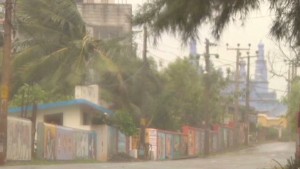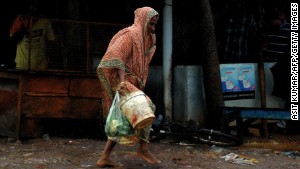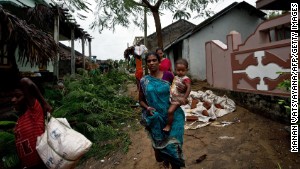
STORY HIGHLIGHTS
- NEW: Relocating the nearly a million evacuees a challenge, official says
- NEW: Most are housed in nearly 250 emergency shelters
- “Our first priority is to clear the roads,” official says
- To avoid electrocution, authorities cut the electricity in affected districts
New Delhi, India (CNN) — Hours after it snapped power lines, overturned cars and ripped away bamboo homes, the most powerful cyclone to hit India in years weakened Sunday, but not before it left at least seven dead.
Morning light revealed damage from Tropical Cyclone Phailin after it pounded the eastern coast, the strongest storm in India in 14 years.
Debris littered wet streets; gaping holes replaced roofs and windows in buildings.
At least seven deaths were confirmed, said Prabhat Mohapatra, a special relief commissioner in Odisha state, where the cyclone landed.
Strong winds overturned cars like toys across Brahmapur city, where the center of the storm struck Saturday along the Bay of Bengal.
“Ganjam is the worst affected district with massive destruction,” said Kamal Lochan Mishra, a state disaster management official. “Our first priority is to clear the roads and we expect all the roads across districts to be cleared by noon.”
 Cyclone slams India’s east coast
Cyclone slams India’s east coast
 See Cyclone Phailin make landfall
See Cyclone Phailin make landfall
 Powerful cyclone makes landfall in India
Powerful cyclone makes landfall in India
Brahmapur is in Ganjam district. As a precautionary measure, authorities cut the electricity in the affected districts.
Like a fierce hurricane
Hurricanes are known as cyclones in the Indian Ocean.
At 140 mph wind speed, Phailin made landfall the equivalent to a Category 4 hurricane. The strongest hurricane is a Category 5, which comes with winds greater than 155 mph.
By Sunday, some 13 hours later, it was the equivalent of a Category 1 hurricane with winds of about 80 mph.
‘Zero-casualty approach’
India evacuated nearly a million people before the storm to avoid a repeat of what happened in 1999, when a cyclone killed 10,000 people.
“We have taken a zero-casualty approach,” said Kamal Lochan Mishra, the Odisha state disaster manager. “If people do not move, force will be used to evacuate them.”
Phailin has brought nearly 8 inches of rain to Odisha’s capital of Bhubaneswar, about 30 miles from the coast. The city’s average rainfall for October is 6.5 inches.
The storm will continue to fall apart as it moves over land, but tropical-storm-force winds are still possible through early Monday, said CNN Meteorologist Judson Jones. Rainfall will also be a problem as Phailin moves up toward the Himalayas in Nepal.
Multiple states in the region were under weather warnings for excessive rainfall and thunderstorms.
Hundreds of emergency shelters
About 900,000 were evacuated in Odisha alone. Most in low-lying coastal areas of the state left on foot or by bicycle, Kamal Lochan Mishra said.
Relocating evacuees is a major challenge because of property damage and losses caused by the storm, said Naveen Patnaik, chief minister for Odisha state.
Most are housed in nearly 250 emergency shelters set up in sturdy buildings like schools and government offices.
The India Meteorological Department warned of extensive damage to houses made of flimsy materials like mud and bamboo, as well as damage to old buildings.
Power and communication lines got disrupted. Extensive flooding also affected rail and road traffic, and crops are likely to suffer major damage, it said.
In Gopalpur, a coastal resort town in Ganjam, restaurants were shuttered and streets deserted. Tourists and local residents left the town.
Military deployed
In October 1999, Cyclone 05B, also known as the Odisha Cyclone, made landfall in the same area, killing 10,000 people. It was the strongest tropical cyclone recorded in the Bay of Bengal, with winds of 155 mph at landfall,. It caused more than $2 billion in damage.
In advance of Phailin, military units and National Disaster Response Force personnel were deployed to coastal areas with relief supplies and medical aid, CNN-IBN said.
All flights to Odisha have been canceled and train services in the state are also disrupted, CNN’s sister network reported.
Disaster preparedness
International humanitarian organization World Vision said it was helping local community groups prepare for the cyclone’s arrival.
“In a storm of this magnitude there is the potential for widespread damage to crops and livestock in the low-lying coastal areas and houses completely wiped away,” said Kunal Shah, the head of World Vision’s emergency response in India. “So while we are praying this storm loses intensity, we’re also preparing.”
The organization has worked for years to train local people in disaster preparedness, including search and rescue, basic first aid and how to protect livestock . It has thousands of emergency response kits ready to hand out where needed.
CNN’s Neha Sharma reported from New Delhi, and Faith Karimi wrote and reported from Atlanta. CNN’s Pedram Javaheri and Radina Gigova contributed to this report.
Link:
Deaths, destruction after India cyclone
The post Deaths, destruction after India cyclone appeared first on Arne Ruhnau News.
via Arne Ruhnau News http://arneruhnau.com/deaths-destruction-after-india-cyclone/
No comments:
Post a Comment